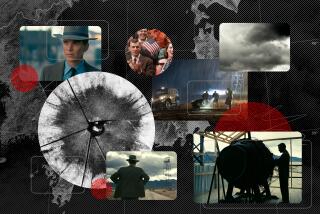With a brush of his pen
As a talented young man starting out in the 1950s, John Updike, whose fiction had already appeared in the New Yorker, spent a year in England studying at the Ruskin School of Drawing and Fine Art. Although Updike went on to make his name as an artist of the written word, he’s maintained his lifelong love for the art of painting.
Updike’s love of the visible world imparts a painterly quality to his literary style, while his intimate knowledge of the visual arts, American painting in particular, made “Seek My Face” (2002), about a fictional American woman artist, one of his most satisfying novels. For decades now, he’s also reviewed art exhibitions and in 1989 published a collection of these essays modestly titled “Just Looking.” Since then, he’s still been looking, as the engaging pieces in his new collection amply testify.
Handsomely illustrated and arranged in order of their subjects’ eras, the essays in “Still Looking: Essays on American Art” constitute a kind of informal history of American art from 18th century portraitist John Singleton Copley to Pop icon Andy Warhol. Updike’s approach is primarily appreciative but by no means uncritical. Above all, it is insightful and rendered even more so by his masterly skills as a writer.
Updike’s keen eye and pungent, aphoristic phrases make for art criticism that sticks in the mind. Struck by the surprising degree of expressiveness in the stiff-looking faces painted by Copley, he remarks: “If one attends sufficiently to the surfaces, the interior takes care of itself: this could be the moral of Copley’s American portraits.”
Before 1820, there was no American landscape art: Nature, as Updike wryly puts it, was invisible, “the Dreadful Other, barely peeping into the windows of the staid indoor portraits of the upstanding citizenry....Who would want to buy a picture of trees, rocks, and poison ivy when the reality stretched for miles on all sides?”
Only after William Wordsworth and his American disciples William Cullen Bryant and Henry Wadsworth Longfellow opened people’s eyes to nature’s sublimity did 19th century painters such as Thomas Cole, Frederic Church and Martin Heade begin to explore the grandeur around them.
Updike is just as illuminating on Winslow Homer, Albert Pinkham Ryder, Thomas Eakins, James McNeill Whistler, Childe Hassam, Edward Hopper, Jackson Pollock, sculptor Elie Nadelman, photographer Alfred Stieglitz, Georgia O’Keeffe, Marsden Hartley and America’s first Abstractionist, Arthur Dove. Updike is warmly and contagiously enthusiastic about Homer: “There is in him a stunning, almost mad absence of two major presences in modern art: theory, and cities.... Whistler, the expatriate who wasted much of his talent on theorizing and posturing, was the anti-type of his reclusive contemporary. With Homer, we feel no waste.... He beautifully exploited his talent and his days.... “
Meditating on the link between the visionary, mystical Ryder (whom Pollock called the only painter he admired) and Pollock himself, killed in a drunken car crash, Updike observes: “Americans, with their basically millennial expectations, admire holy fools, especially in the arts, and Ryder is our holy fool of painting.”
Certainly it’s hard to doubt Ryder’s sincerity, but what was the point of using materials he had good reason to know would soon corrode? Updike appears to allow Ryder’s (and Pollock’s) claim that the “art” here resides less in the finished result than in the artist’s ecstatic feelings as he produced the canvas. But he doesn’t take issue with the obvious ridiculousness inherent in such a theory: If a couple experience sublime moments in love-making or a surfer transcendent emotions riding a wave, are soaked sheets and battered surfboards masterworks of art? But Updike’s endorsements are somewhat qualified, a tongue-in-cheek skepticism lurking beneath his admiration.
Updike’s true feelings about Abstract Expressionism and its antithetical successor, Pop Art, are somewhat tricky to fathom. In “Seek My Face,” the Updike-like heroine Hope Chafetz, having been married to practitioners of both styles, clearly sees the limitations of each: the willful impermanence of the first, the willed triviality of the second. But in most of these essays, Updike is more measured -- or perhaps more guarded -- expressing what may be his deeper feelings through a finely permeable veil of irony.
He finds the “American yearning for the Sublime” in the “dangerous high-wire act” of the Abstract Expressionists: “The painter assumed the role of hero, not by virtue of what he witnessed and recorded but by all the traditional props ... he disdained in his visible wrestling with paint itself. The episode,” he concludes a touch dryly, “was understandably brief, from 1943 to about 1960; we cannot take the sublime as a daily dose.”
Of Warhol, Updike notes: “His fifteen minutes are still stretching, and there is an uncanny, unearthly beauty and rightness to his work.... St. Andy, the benign, wan apostle of surface and nullity, reconciling us to a cluttered world emptied of more than superficial content. He didn’t appear to have normal feelings, but maybe this was the new normal.”
The artist Updike seems to love best is the incomparable Edwin Hopper: “If one asks what elevates Hopper above the relatively programmatic and clamorous art of his contemporaries, the quality might be called largeness -- a largeness of patience and peripheral vision....” Somehow, Updike manages to lay his finger on just what makes Hopper’s work so haunting. Like all good art and all good writing, Updike’s art criticism helps us see things more clearly, more deeply, with more discernment and, above all, more gusto.
Merle Rubin is a contributing writer to Book Review.
More to Read
The biggest entertainment stories
Get our big stories about Hollywood, film, television, music, arts, culture and more right in your inbox as soon as they publish.
You may occasionally receive promotional content from the Los Angeles Times.






